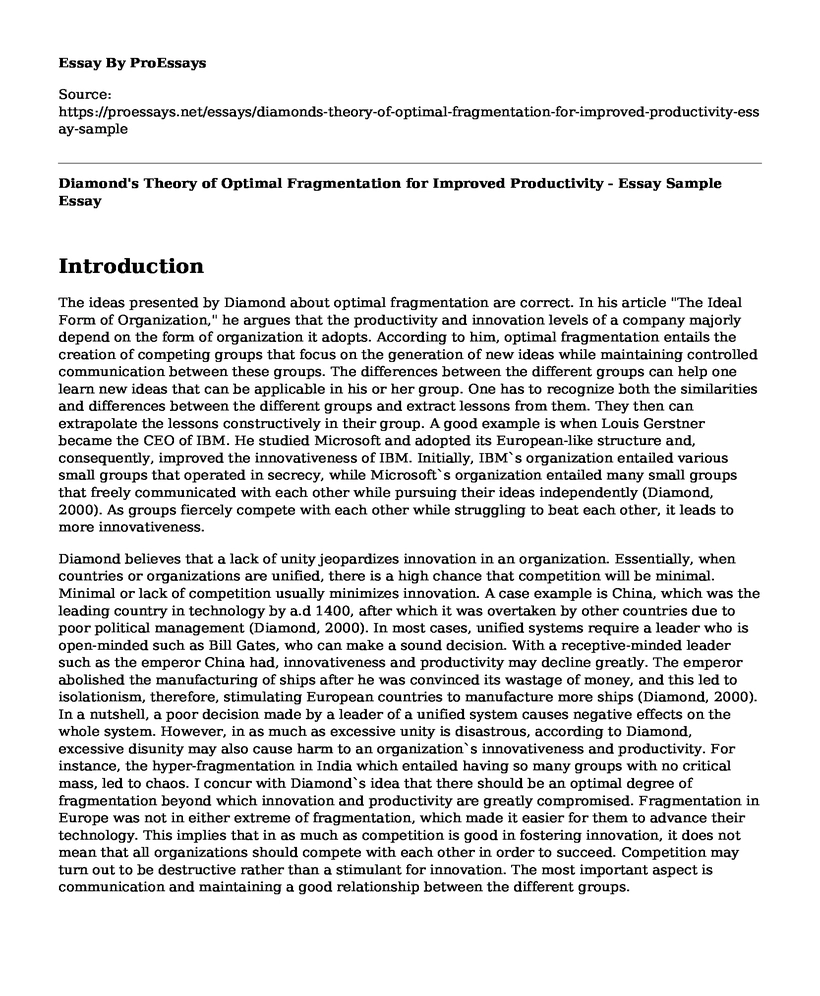Introduction
The ideas presented by Diamond about optimal fragmentation are correct. In his article "The Ideal Form of Organization," he argues that the productivity and innovation levels of a company majorly depend on the form of organization it adopts. According to him, optimal fragmentation entails the creation of competing groups that focus on the generation of new ideas while maintaining controlled communication between these groups. The differences between the different groups can help one learn new ideas that can be applicable in his or her group. One has to recognize both the similarities and differences between the different groups and extract lessons from them. They then can extrapolate the lessons constructively in their group. A good example is when Louis Gerstner became the CEO of IBM. He studied Microsoft and adopted its European-like structure and, consequently, improved the innovativeness of IBM. Initially, IBM`s organization entailed various small groups that operated in secrecy, while Microsoft`s organization entailed many small groups that freely communicated with each other while pursuing their ideas independently (Diamond, 2000). As groups fiercely compete with each other while struggling to beat each other, it leads to more innovativeness.
Diamond believes that a lack of unity jeopardizes innovation in an organization. Essentially, when countries or organizations are unified, there is a high chance that competition will be minimal. Minimal or lack of competition usually minimizes innovation. A case example is China, which was the leading country in technology by a.d 1400, after which it was overtaken by other countries due to poor political management (Diamond, 2000). In most cases, unified systems require a leader who is open-minded such as Bill Gates, who can make a sound decision. With a receptive-minded leader such as the emperor China had, innovativeness and productivity may decline greatly. The emperor abolished the manufacturing of ships after he was convinced its wastage of money, and this led to isolationism, therefore, stimulating European countries to manufacture more ships (Diamond, 2000). In a nutshell, a poor decision made by a leader of a unified system causes negative effects on the whole system. However, in as much as excessive unity is disastrous, according to Diamond, excessive disunity may also cause harm to an organization`s innovativeness and productivity. For instance, the hyper-fragmentation in India which entailed having so many groups with no critical mass, led to chaos. I concur with Diamond`s idea that there should be an optimal degree of fragmentation beyond which innovation and productivity are greatly compromised. Fragmentation in Europe was not in either extreme of fragmentation, which made it easier for them to advance their technology. This implies that in as much as competition is good in fostering innovation, it does not mean that all organizations should compete with each other in order to succeed. Competition may turn out to be destructive rather than a stimulant for innovation. The most important aspect is communication and maintaining a good relationship between the different groups.
Conclusion
In conclusion, it is the responsibility of managers to know the advantages and drawbacks of centralization and fragmentation in the organization. Extrapolation of ideas from preindustrial society into modern businesses may seem ridiculous, but it is practical. Diamond drew his conclusions from comparing the differences in innovation and productivity among companies such as Microsoft and IBM, industrial belts such as Silicon Valley and route 128, countries such as Japan and the USA, and industrial sectors such as food and the electronic industries. He stated three factors that create the differences in innovation and productivity which include competition, centralized control and the flow of ideas.
References
Diamond, J. (2000). The Ideal Form of Organization. Wall Street Journal, 12, A17....
Cite this page
Diamond's Theory of Optimal Fragmentation for Improved Productivity - Essay Sample. (2023, Mar 04). Retrieved from https://proessays.net/essays/diamonds-theory-of-optimal-fragmentation-for-improved-productivity-essay-sample
If you are the original author of this essay and no longer wish to have it published on the ProEssays website, please click below to request its removal:
- The Relationship Between Empowering Leadership and Intention to Share Knowledge in the Context of NGOs
- Management Decision Problem for Increasing Share of the Athletic Shoe Market
- Research Paper on McDonald's in Morocco
- The Failure of FDA of Rofecoxib Case Study Paper Example
- Inter-Professional Teamwork in Healthcare Essay
- Research Paper on DNP Leader's Political Competence: Enhancing Performance in the Workplace
- Essay on Jill's Struggle to Turn Around Club Lido: Challenges of Establishing a Service-Oriented Culture







